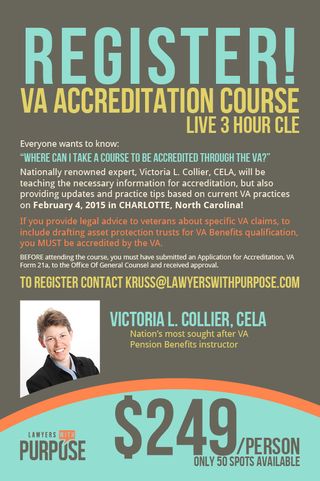The VA annually updates the amount paid to Veterans and widows for the Improved Pension Program. Here are the latest amounts which became effective December 1 , 2019 and will likely continue until December 1, 2020.
How to Represent a Claimant Before the VA: The Appeals Process
LWP’s Director of VA Services, Matthew Donald, Esq., provides an overview of the VA Appeals Process.
Submitting Medical Expenses to the VA
Why submit medical expenses?
When applying for Wartime Pension benefits through the Veterans Administration, the claimant must meet both income and asset limitations. Practitioners focus mostly on reducing assets to qualify; however, the claimant’s income must also meet the income standard. A claimant’s yearly family income must be less than the maximum annual pension rate (MAPR) amount set by Congress for any particular year to qualify. Unlike transferring assets to qualify, a claimant cannot transfer income in order to reduce or eliminate it for VA purposes. Sometimes the only way to reduce countable annual income for a claimant is to provide documentation to the VA of allowable medical and dental expenses to offset that income. Considering how medical expenses play a crucial role is critical to a successful claim.
 What medical expenses may be submitted?
What medical expenses may be submitted?
Not all medical expenses are considered allowable by the VA. The medical or dental expense must have actually been paid by the claimant or claimant’s spouse and be unreimbursed by insurance or any other source, and it may be incurred by any member of the claimant’s household, and even by non-dependents in some cases. The VA provides the following list of examples of medical expenses that might be considered in their instructions for VA form 21P-8416:
- Hospital expenses
- Doctor's office fees
- Dental fees
- Prescription/non-prescription drug costs
- Vision care costs
- Medical insurance premiums
- Monthly Medicare deduction
- Nursing home costs
- Hearing aid costs
- Dental fees
- Home health service expenses
- Expenses related to transportation to a hospital, doctor, or other medical facility
The VA Adjudication Manual gives a more detailed list of common allowable medical expenses in M21-1MR, Part V, Subpart iii, Chapter 1, Section G.42.c. From the total annual medical expenses that the VA considers, only that part which is more than 5% of the maximum rate of pension for your particular claimant may be deducted from income. Thus, you must always consider this deductible when seeking to offset income with medical expenses. The Lawyers with Purpose VA Qualification Worksheet automatically makes this calculation for you.
The VA must consider all expenses that are directly related to medical care, even though this care does not necessarily have to be provided by a licensed health professional. This applies most notably in the case of home health care when the “VA has rated the disabled person (beneficiary or Veteran’s spouse if the Veteran is dually entitled to compensation of at least 30 percent) entitled to A&A or Housebound,” M21-1MR, Part V, Subpart iii, Chapter 1, Section G.43.d.
When to submit medical expenses
Medical expenses should be submitted to the VA at essentially three different times: at the initial application stage, and once approved, after the end of any particular calendar year and whenever there is a significant change in medical expenses. There are two categories of medical expenses that the VA recognizes: prospective and actual medical expenses that are related to when you submit medical expenses. Pursuant to the VA Adjudication Manual M21-1MR, Part V, Subpart iii, Chapter 1, Section G.44.d, “normally, medical expenses are deducted from an award after the fact, based on the claimant’s report of expenses actually paid. However, under 38 CFR 3.272(g), medical expenses may be allowed prospectively if the claimant is paying recurring nursing home fees or other reasonably predictable medical expenses.” When you first apply for VA benefits, you should submit prospective medical expenses for the 12-month period following the effective date. Unfortunately, nowhere is it defined what is considered “reasonably predictable,” and this determination is left to the discretion of the individual adjudicator. In my firm’s experience, the VA will often not consider prescription costs, incontinence supplies, or over-the-counter medical supplies or medications as “reasonably predictable” recurrent monthly medical expenses.
After approval of VA benefits, all actual medical expenses may be submitted for the VA’s consideration. You have until the end of any year to submit actual medical expenses for the prior calendar year. You only need to submit actual medical expenses each year if you are relying on those actual expenses to offset income. If the recurring medical expenses are sufficient to offset the claimant’s income, there may be no need to update the VA annually regarding actual medical expenses. The only other time you should submit medical expenses to the VA is when these change significantly. An increase in medical expenses may not make a difference in the amount of benefits paid but should be reported to the VA nonetheless. A decrease in medical expenses may mean a reduction or even termination of benefits, thus it is important to notify the VA as soon as possible regarding a decrease in order to avoid a potential overpayment of benefits.
How to submit medical expenses
The main application forms for non-service-connected pension – the VA forms 21-527EZ and 21-534EZ – both have small sections for reporting medical expenses. However, there is one specific VA form used exclusively for medical expense submission: VA form 21P-8416 “Medical Expense Report.” You are, however, not required to notify the VA of medical expenses using this particular form. As long as your submission includes the specific purpose for which the payments were made, the amount paid, the date paid, the name of the provider, and for whom the expense was paid, that is sufficient to constitute notification. Generally the VA will accept notification of medical expenses without supporting documentation like receipts unless the adjudicator has cause to question any of the expenses. For this reason, you should advise your client’s family to maintain records of all medical expenses for at least three years, in case the claimant is ever called upon to substantiate those expenses.
Expected changes for medical deductions
In January 2015, the VA issued proposed changes to the regulations governing deductible medical expenses. Of note, when the rules become “final” (expected in February 2016), the VA will no longer count the fees charged by independent living facilities as deductible medical expenses and will cap the deductibility of home health care at $21 per hour.
Please join Dave Zumpano, Sabrina Scott (Director of VA Services, LWP), Kimberly Brannon (Technical-Legal) and me on Monday, December 14 at 4:00 pm eastern as we have a panel discussion of the 2016 VA changes, VA planning and accept your questions. It is our duty as the leading estate planning attorneys in the nation to be prepared and educated on the VA changes coming in 2016, and we at LWP are excited to make sure all of our members are ready and educated when the changes take place.
Registration Link: https://attendee.gotowebinar.com/rt/8232313303938319617
By Sabrina A. Scott, Paralegal, The Elder & Disability Law Firm of Victoria L. Collier, PC, and Director of VA Services for Lawyers With Purpose.
Victoria L. Collier, Veteran of the United States Air Force, 1989-1995 and United States Army Reserves, 2001-2004. Victoria is a Certified Elder Law Attorney through the National Elder Law Foundation; Author of “47 Secret Veterans Benefits for Seniors”; Author of “Paying for Long Term Care: Financial Help for Wartime Veterans: The VA Aid & Attendance Benefit”; Founder of The Elder & Disability Law Firm of Victoria L. Collier, PC; Co-Founder of Lawyers with Purpose; and Co-Founder of Veterans Advocate Group of America.
Avoiding The Five Major Threats To IRA’s: Part 4
As I have been discussing there are five threats to qualified accounts that most people don’t typically consider when doing estate planning. The five major threats to qualified plans are unexpected loss to income taxes, excise taxes, long-term care costs (all covered previously), estate taxes (today’s topic) and to beneficiaries and/or their creditors. As we’ve previously outlined, the threats of incomes taxes and excise taxes can easily be avoided if planned for, and the threat to long-term care costs can be planned for with the least risk by completing an IRA analysis to determine if an IRA should be liquidated or annuitized when the IRA owner becomes subject to long term care costs. When it comes to protecting qualified accounts from estate tax, it is more challenging.
 If an individual dies with assets greater than $5,340,000.00 their estate is subject to a forty percent estate tax. When this occurs, the IRA (or other qualified asset) can be subject to more than seventy five percent in total taxes. How? Well assuming a $1 million IRA is part of a $7 million estate, the IRA will be subject to estate tax of forty percent ($400,000.00) and upon the liquidation of the IRA by the beneficiaries it could be taxed at a rate of up to thirty nine point six percent (39.6%), which results in an additional $396,000.00 in income tax if the beneficiary is in the highest income tax bracket. To add insult to injury, there is no deduction on the value of the estate tax return for the income tax due on the IRA. As if federal taxes were not enough, there can be state income taxes dues when the IRA is liquidated to pay the federal estate tax. It gets even worse if you live in a state that has an estate tax. A state estate tax is yet one more tax on top of the federal estate and income taxes, and state income taxes. Most states estate taxes are up to an additional sixteen percent. And so the question becomes, how do you protect qualified accounts from estate tax liabilities?
If an individual dies with assets greater than $5,340,000.00 their estate is subject to a forty percent estate tax. When this occurs, the IRA (or other qualified asset) can be subject to more than seventy five percent in total taxes. How? Well assuming a $1 million IRA is part of a $7 million estate, the IRA will be subject to estate tax of forty percent ($400,000.00) and upon the liquidation of the IRA by the beneficiaries it could be taxed at a rate of up to thirty nine point six percent (39.6%), which results in an additional $396,000.00 in income tax if the beneficiary is in the highest income tax bracket. To add insult to injury, there is no deduction on the value of the estate tax return for the income tax due on the IRA. As if federal taxes were not enough, there can be state income taxes dues when the IRA is liquidated to pay the federal estate tax. It gets even worse if you live in a state that has an estate tax. A state estate tax is yet one more tax on top of the federal estate and income taxes, and state income taxes. Most states estate taxes are up to an additional sixteen percent. And so the question becomes, how do you protect qualified accounts from estate tax liabilities?
The answer is you really can’t, without first liquidating the IRA and paying the income tax (other than an annual $100,000.00 gift allowed to charity). So in order to protect IRA’s from federal and state estate taxes requires the reduction of a client’s non IRA estate during lifetime so the total estate evaluation does not exceed the estate tax limits. One strategy to do this is annual gifting, which can be effective, but often requires a significant number of beneficiaries to distribute the annual growth on an estate of that size. For example, if an individual had a $7 million estate and it grew at three percent the individual would have to give away $210,000.00 per year just to keep the estate from growing. That would require fifteen beneficiaries to distribute $14,000.00 to or eight beneficiaries if the client is married.
Another strategy to reduce estate taxes is to give away money to charity. An individual can have the ability to benefit charities and their family by use of various strategies which is outside the scope of this writing. A third way to reduce estate taxes is by using legal strategies to discount the value of assets by use of various tax planning techniques. Unfortunately none of these strategies work to reduce an IRA’s value other than outright gifting after withdrawal and the payment of income tax or use of the annual allowance for distributions from qualified account to charity. In summary, subjecting qualified accounts to estate taxes is a significant burden to the tax payer which only can be minimized by ensuring their non-qualified estate is reduced and moving to a state without income tax can reduce the income tax burden. Obviously qualified accounts are very appealing as they have tax referral advantages, but one must weigh the long term benefit of the difference with the tax cost upon receipt or death.
If you want to learn more about what it's like to be a Lawyers With Purpose member, join our 3.5 day Practice With Purpose Program (you can find the agenda here). We still have a few spots left so grab them now! It's a jam packed 3.5 days that include all the essentials on Asset Protection, Medicaid & VA for your estate or elder law practice.
David J. Zumpano, Esq, CPA, Co-founder Lawyers With Purpose, Founder and Senior Partner of Estate Planning Law Center
Annual Termination Of VA Aid & Attendance
We just started a New Year and many recipients of the VA Pension with Aid and Attendance will lose their benefits this year. Why? Because of a letter VA applicants receive after they have been approved for benefits. The first letter, issued in January 2013, contained the news, originally given in a VA press release on December 20, 2012, that the annual Eligibility Verification Report (EVR) was no longer a requirement. For individuals who had experienced the “old” EVR process, this was quite exciting.
 Why the excitement? The EVR was the yearly submission by the Veteran to update the VA with current income and medical expenses. It is a tedious task, both for our clients who had to keep records of all medical expenses and for law firms who cannot charge for these additional services. Foregoing this task saves time and stress.
Why the excitement? The EVR was the yearly submission by the Veteran to update the VA with current income and medical expenses. It is a tedious task, both for our clients who had to keep records of all medical expenses and for law firms who cannot charge for these additional services. Foregoing this task saves time and stress.
Why did the VA discontinue the practice? According to the press release, the VA stated that the change allowed them to:
(1) Reallocate the staff who had processed the EVRs to instead tackle the compensation claim backlog, and
(2) The VA could now obtain current income information directly from Social Security and the Internal Revenue Service.
This sounds like a beautiful plan. However, in the absence of updated unreimbursed medical expenses (UME), which is what reduces the “countable income” to meet VA eligibility criteria, the VA will continue to use the last reported medical expenses when reviewing eligibility for ongoing years. This means that for any VA beneficiary whose medical expenses are just high enough to offset their income at the time of application, may have benefits terminated with future increases in income (cost of living adjustment increases, etc.). Therefore, while the VA says that it does not require annual reviews, it is important to meet with your VA benefits clients to assess changes in income and medical expenses that could impact receipt of VA benefits. The best time to meet is after the tax deadline of April 15 when it can be expected that your clients have gathered the prior year’s medical expenses in order to file their tax returns.
Use VA form 21P-8416 when updating medical expenses for the VA. The VA will consider UMEs submitted through December 31st of the following year for the prior year’s “eligibility period” in which the UME was paid. For example, you have until December 31, 2015 to submit UMEs incurred and paid for during the calendar year 2014. It is not necessary to provide receipts of those medical expenses as long as the VA Form 21P-8416 clearly identifies the nature of the expense, the provider, the date, and for whom the expense was paid. Along with the 21P-8416 for actual unreimbursed medical expenses for the prior year (i.e. 2014), it is also recommended to complete an additional VA Form 21P-8416 with “projected” UMEs for the current year (i.e. 2015). These are both filed with VA Form 21-4138, Statement in Support of Claim, requesting that the VA consider these medical expenses. This should be submitted to the pension management center where you file your pension claims. You will generally only get a response from the VA to this submission when it requires a change in the monthly VA benefit; otherwise, the only indication that the submission has been received, considered and accepted is the continuation of the claimant’s monthly benefit.
Victoria L. Collier, CELA, Elder Care Attorney, Co-Founder of Lawyers for Wartime Veterans and Lawyers with Purpose, Veteran, author of 47 Secret Veterans Benefits for Seniors and most recent book, Paying for Long Term Care: Financial Help for Wartime Veterans: The VA Aid & Attendance Benefit.
If you're interested in learing more from Victoria L. Collier, join us in Charlotte, NC, February 4th, where she will be LIVE in the room offering VA Accreditation. We only have a FEW SPOTS left so register NOW with Kyle Russ at kruss@lawyerswithpurpose.com.
Your Family, Your Community, and Your Profession
Your Family, Your Community, and Your PAs professionals who work with seniors and their families, we're in a unique position to serve our loved ones, our communities, and to help the brave men and women who have served our country as well.
 I'm here today to tell you that we really can have it all! A thriving practice with purpose, the seemingly elusive work/life balance, and the satisfaction that comes with knowing that you're doing good for the people around you.
I'm here today to tell you that we really can have it all! A thriving practice with purpose, the seemingly elusive work/life balance, and the satisfaction that comes with knowing that you're doing good for the people around you.
I've prepared a short video for you about how you can achieve the same success in your practice as well…take ninety seconds and check it out. It may be the best thing you do for your practice today!
To your success,
Victoria L. Collier, CELA, Elder Care Attorney, Co-Founder of Lawyers for Wartime Veterans and Lawyers with Purpose, Veteran, author of 47 Secret Veterans Benefits for Seniors and most recent book, Paying for Long Term Care: Financial Help for Wartime Veterans: The VA Aid & Attendance Benefit
Hidden Dangers of Medicaid Qualifying Annuities
Today, many elder law attorneys rely on Medicaid qualifying annuities to get their clients qualified to receive Medicaid benefits. They're also used when clients seek VA pension benefits.
While Medicaid qualifying annuities have become the default solution, they are not without risk. One challenge is that MQA's do not work well for single individuals. Second, even when used in married planning, there is no assurance the amount placed in the Medicaid qualifying annuity will actually be preserved. In fact, it could all be lost with the subsequent disability or death of the community spouse.
 These are just some of the issues (not to mention the Veterans Administration's changing position on annuities when applying for veteran pension benefits) that we will be discussing at the Asset Protection, Medicaid and VA Practice With Purpose Program October 20-22nd in Phoenix, AZ.
These are just some of the issues (not to mention the Veterans Administration's changing position on annuities when applying for veteran pension benefits) that we will be discussing at the Asset Protection, Medicaid and VA Practice With Purpose Program October 20-22nd in Phoenix, AZ.
National Asset Protection, Medicaid and VA experts and dozens of attorneys like you will be collaborating to identify the hidden risks in the different Medicaid and veterans' benefits strategies. This program promises to be the hands-on strategic solving many lawyers crave in their practice. Click here to get a full outline and to register for the program.
In these three days here is just some of what we will cover:
ASSET PROTECTION:
- Recent updates to asset protection and Medicaid compliant strategies.
- The new asset protection strategies dominating the marketplace.
- The death of DAPT'S, FLP'S, GRATS, GRUTS, and tax planning, and what's replaced them.
- The five essential trusts and key drafting needs to serve 99.7% of clients.
- The Power of Powers of Appointment, in the right places.
- Four "must have" drafting considerations and three "most forgotten" powers in trust.
MEDICAID:
- Four steps to Medicaid eligibility for any client.
- How to calculate the "breakeven" to ensure the proper filing date for the shortest penalty period.
- Medicaid Qualifying Annuities: Hidden risks and how to properly disclose them to clients or protect from them.
- The seven key factors to calculate any Medicaid case in seven minutes (or less!).
- IRA's: Exemption versus taxes, how to calculate if IRA's should be liquidated or exempted in Medicaid and VA cases.
VETERANS' BENEFITS:
- New fully developed claims process for veterans and widows.
- Qualifying assisted living facilities as UME's.
- Key language to complete the physician affidavit for more timely approvals.
- Update on three year look back for VA benefits.
- The key reports no longer required for VA applications.
- Dangers of annuities in VA benefits planning.
- The effects of the Supreme Court decision on DOMA related to veterans' benefits.
HERE'S WHAT YOUR PEERS HAD TO SAY ABOUT THE PROGRAM:
- "It will change your practice and your life!" –John Koenig
- "Great way to grow into a real firm and help one's community." –Antoinette Middleton
- "Go to the training session and consider and evaluate upgrading your delivery of services, for me it's modernizing what I can offer." –Wally Kelleman
Are you going to miss or attend the most important event of the year? Click here now to join some of your most successful colleagues and leave confident in the strategies you provide to your clients every day.
David J. Zumpano, Esq, CPA, Co-founder Lawyers With Purpose, Founder and Senior Partner of Estate Planning Law Center
How Efficient Is Your Law Firm?
Tom was making the same colossal mental mistake most attorney practitioners make, thinking he was doing everything he could to eke out a respectable living. He certainly was working hard enough.
 Tom and his partner Richard started their practice together a few years ago. They both thought they could earn a better living than working for their respective law firms.
Tom and his partner Richard started their practice together a few years ago. They both thought they could earn a better living than working for their respective law firms.
It didn't take long for reality to set in. Their hours were longer and they earned far less per hour than they had when they had employers.
They hired an admin, Sally, about a year ago. It definitely helped but there were still problems.
After Tom read the intro to the Revenue Focuser Workbook, he was definitely intrigued.
He coordinated two hours for himself, his partner, and their admin to watch the video and work through the workbook.
Tom and Richard thought about how much they really wanted to pay themselves every month. Since they'd opened their doors, they had never been able to pay themselves that magic number.
They also recognized that, for some reason, their marketing efforts were unfocused and never attracted the right clientele. They could only help a small percentage of the prospects who called them.
Together the three identified their key revenue-generating services. They added up the hours they spent delivering each service.
Tom and Richard also looked at the total hours they spent in the office each week. They felt a knot in the pit of their stomachs when they discovered their office was operating at less than 20% of efficiency. In fact, they barely operated at 19% efficiency.
Tom and Richard realized it was time to figure out how to retool their processes so they could handle their clients more efficiently; they also needed to determine how to attract the right clientele.
If you haven't worked through your Revenue Focuser, it could be the most important hour you spend. When you decide it's time to eliminate the long hours and the feeling of being overwhelmed,take 1 hour and Complete the Lawyers With Purpose Revenue Focuser.
The income you want to earn and the ease you want to experience is within your reach.
If you have any questions about your Revenue Focuser results, send us your questions on the form on our contact page. Just send an email to info@lawyerswithpurpose.com.
And, if you're interested in learning more about Lawyers With Purpose, please click here and register today to attend our Practice With Purpose Program in Phoenix, AZ, October 20-22nd. We'll see you then!
To your success,
Dave Zumpano
Lawyers With Purpose
Congratulations to Peggy Timmel, LWP Member Of The Month
What is the greatest success you’ve had since joining LWP?
Organization + Confidence = Increasing Success. That’s the formula we now have in place. Sure, we still are working through some of the processes, making them our own and getting the kinks worked out when and as needed. Not all clients initially expect the process to be as involved, but there is no doubt that our efforts are appreciated.
 What is your favorite LWP tool?
What is your favorite LWP tool?
LWP Meeting Focuser (the green sheet) – it may sound strange to some members, but that sheet is reviewed at the end of client meetings so that tasks are delegated and the next meeting with the client put on the calendar. I’ve been using it for cases that are pre-LWP or non-LWP, like guardianships. It keeps our team more focused and allows us to move our clients through the entire process more smoothly.
How has being part of LWP impacted your team and your practice?
We get to travel three times a year and always come back with something to improve our practice. It has been incredibly helpful to have the support system that LWP provides. The members provide a great community of support and the LWP systems and processes give us a great foundation to continually improve our practice.
MQA’s Hidden Dangers
Today, many elder law attorneys rely on Medicaid qualifying annuities to get their clients qualified to receive Medicaid benefits. They're also used when clients seek VA pension benefits.
 While Medicaid qualifying annuities have become the default solution, they are not without risk. One challenge is that MQA's do not work well for single individuals. Second, even when used in married planning, there is no assurance the amount placed in the Medicaid qualifying annuity will actually be preserved. In fact, it could all be lost with the subsequent disability or death of the community spouse.
While Medicaid qualifying annuities have become the default solution, they are not without risk. One challenge is that MQA's do not work well for single individuals. Second, even when used in married planning, there is no assurance the amount placed in the Medicaid qualifying annuity will actually be preserved. In fact, it could all be lost with the subsequent disability or death of the community spouse.
These are just some of the issues (not to mention the Veterans Administration's changing position on annuities when applying for veteran pension benefits) that we will be discussing at the Asset Protection, Medicaid and VA Practice With Purpose Program June 9th – 11th in Chicago.
National Asset Protection, Medicaid and VA experts and dozens of attorneys like you will be collaborating to identify the hidden risks in the different Medicaid and veterans' benefits strategies. This program promises to be the hands-on strategic solving many lawyers crave in their practice. Click here to get a full outline and to register for the program.
In these three days here is just some of what we will cover:
ASSET PROTECTION:
- Recent updates to asset protection and Medicaid compliant strategies.
- The new asset protection strategies dominating the marketplace.
- The death of DAPT'S, FLP'S, GRATS, GRUTS, and tax planning, and what's replaced them.
- The five essential trusts and key drafting needs to serve 99.7% of clients.
- The Power of Powers of Appointment, in the right places.
- Four "must have" drafting considerations and three "most forgotten" powers in trust.
MEDICAID:
- Four steps to Medicaid eligibility for any client.
- How to calculate the "breakeven" to ensure the proper filing date for the shortest penalty period.
- Medicaid Qualifying Annuities: Hidden risks and how to properly disclose them to clients or protect from them.
- The seven key factors to calculate any Medicaid case in seven minutes (or less!).
- IRA's: Exemption versus taxes, how to calculate if IRA's should be liquidated or exempted in Medicaid and VA cases.
VETERANS' BENEFITS:
- New fully developed claims process for veterans and widows.
- Qualifying assisted living facilities as UME's.
- Key language to complete the physician affidavit for more timely approvals.
- Update on three year look back for VA benefits.
- The key reports no longer required for VA applications.
- Dangers of annuities in VA benefits planning.
- The effects of the Supreme Court decision on DOMA related to veterans' benefits.
HERE'S WHAT YOUR PEERS HAD TO SAY ABOUT THE PROGRAM:
- "It will change your practice and your life!" — John Koenig
- "Great way to grow into a real firm and help one's community." — Antoinette Middleton
- "Go to the training session and consider and evaluate upgrading your delivery of services, for me it's modernizing what I can offer." — Wally Kelleman
Are you going to miss or attend the most important event of the year? Click here now to join some of your most successful colleagues in Chicago and to be confident in the strategies you provide every day.
David J. Zumpano, Esq, CPA, Co-founder Lawyers With Purpose, Founder and Senior Partner of Estate Planning Law Center
![]()






